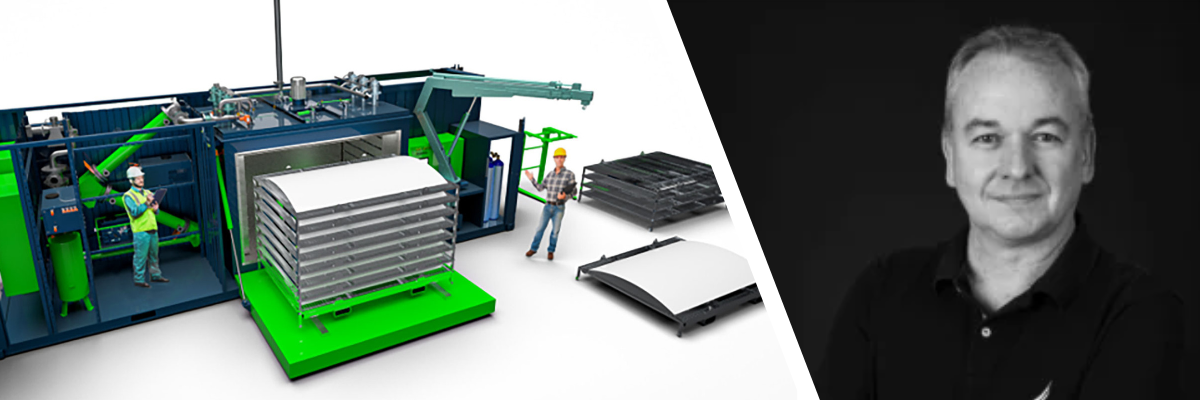 Kim Hollamby
Kim Hollamby
Beneteau’s Sustainability Project of the Year win in last year’s IBI METSTRADE Boat Builder Awards threw a spotlight on the great potential of Swiss company Composite Recycling for its technology that provides viable second use for scrapped Glass Reinforced Plastic (GRP) mat and resin. We ask CEO and Co-Founder Guillaume Perben about the origins of his solution and how it works.
I have a boat based in the Mediterranean and have lived in the South Pacific. Sailing and the sea is very much in our family’s blood.
The father of my son’s best friend, Dr Pascal Gallo, is a physicist. I got to know him well, and we worked on previous recycling projects together. One day, I complained to him that recycling my glass fibre yacht was impossible. He responded that he thought there would be a solution for that.
We both went to speak with Professor Michaud, the head of the Laboratory for Processing of Advanced Composites at the École Polytechnique Fédérale de Lausanne. I was surprised when she assured us of a known solution. It involved using a technique known as pyrolysis – applying heat in an oxygen-free environment to separate the fibres from the resin in waste GRP.
I then returned to my friends in the boating world, who responded that no one knows how to do this. We had identified an addressable gap between fundamental science and the industry.
We found that pyrolysis was in use but with machines that could handle all types of waste, such as tyres, plastic bags, organic waste, and other things. With this type of machine, the recycler must first shred the waste material; otherwise, you have an output that contains large lumps of charred material. So, we decided to design a solution that specialised exclusively on composites.
Next, we looked at how much material might be available to process if we focused only on GRP. We spoke with the European Composite Association and the European Boating Industry trade body. It became clear the volumes were so massive we could be busy for a long time.
Taking all uses of composites (not just the marine industry), Europe produces 500,000 tons of composite waste, which is forecasted to grow to 800,000 tons in 2030.
We’ve designed a machine where you don’t shred or transport the waste. It sits within a 30ft transportable container that uses the same hydraulic hook system employed by waste disposal trucks, making it easy to move, drop off and collect by standard transport.
The pyrolysis process vaporises the resin because you heat it in an oxygen-free environment, so there’s no combustion. When the resultant vapour is condensed, you get oil – we make sure it is of high quality, and in some cases, you can make resin from it again. You also get gas, which we use to power the unit – that helps the economic model.
The fibres remain intact because you’ve not shredded or moved your composites. If you put a piece of boat that is 1m long in the chamber, you will potentially recover fibres that are the same length. We clean them, then they are put to new uses. We don’t melt the fibres to make new glass unless the material is unusable.
We’ve partnered with composites specialists like Chomorat and supply the fibres for weaving into new mats because that is their expertise.
Chomorat mixes the recycled fibres with virgin fibres to create a hybrid chop-stranded mat for use as you would any chopped-stranded mat. That is important as we don’t want shipyard operators to change their processes to accommodate this material. This product is used for the Beneteau project that won the sustainability category in last year’s IBI METSTRADE Boat Builder Awards.
We’ve worked on the fibres’ quality for the past three years to ensure effective reuse. The plan now is to increase the percentage of recycled material from 10 per cent to 20 and then 30 per cent. More surface treatment is required to make those gains, but we’ve made a significant first step.
Three years ago, people talked about lifecycle assessment (LCA), but they were at stage one, which was to consider what you do internally. Today, the world is moving onto stages two and three, which include your suppliers, clients and any other processes that influence the sustainability of what you are doing.
If you consider all solutions for recycling composites, they are all comparable on LCA stage one. If you need to truck your boats to a centralised factory to recycle them, then under LCA stage three, you have a big problem with carbon emissions.
Because composites are used to create lightweight structures, they are typically shapes full of air and bulky to transport. Once you separate the resin from the fibres, they lose their shape and become much easier to transport.
We expect to have the first containerised version of the machine in July and August of this year.
The most significant difference is between the pre-1990s with traditional laminating techniques and the post-1990s when infusion came in. We were working on a 1979 yacht – the thickness of the hull was incredible, with a lot more resin than glass. Today, builders have become experts at using as little resin as possible for glass.
Around 10 to 30 per cent of the laminate used to create a boat can wind up as scrap. That is directly affecting shipyards today. Just think of the big window cutouts on sailing catamarans and motor yachts alone. There are also old boat moulds to deal with.
We’re not a recycling company – we don’t know how to pick up a boat, remove its keel and engine and depollute it. We also don’t know how to de-possess an abandoned boat administratively.
We’ve been working with the Association for Eco-Responsible Yachting (APER) in France and talking to other European organisations. The French are the most advanced country in this area and have told us this issue is not simple. Ultimately, it is likely that nations will need laws to get boat recycling really moving.
It’s a problem if you legislate to force people to do something they cannot do. In Austria, the government recently scrapped its national exemption for composites for a ban on landfilling, incinerating or exporting toxic waste. A lot of scrap composites are now rapidly filling up storage facilities there.
The first one will have a capacity of two tons per day. Taking data from the French, that equates to two average size yachts.
The next generation of containers will do four tons a day; then we’ll probably move to six.
That’s a fundamental question! Companies have told us we are making money from their waste and should pay them for it. The answer is no – if we do that, we incentivise them to produce more waste.
In Western France, it costs you €200/ ton to landfill scrap plus €75 tax. That price is forecast to rise to €300/ton next year. In Northern Italy, it’s €600/ ton.
We charge €200/ton, which is not going up. So instead of paying landfill charges and taxes, the person recycling their waste GRP pays us.
We sell the fibre to the weavers that produce mat at the same price as virgin fibres. We expect they will put a premium on material with recycled mat, but we keep the pricing the same.
We’re working on what happens with the oil, but we expect it to deliver a good revenue stream.
Our economic model works because, in most cases, we produce enough gas to power the unit and are not heavily dependent on energy prices.
We are deep into considering national and EU regulations in this area and have commissioned an engineering bureau in France to help us with this. However, our numbers are encouraging compared to virgin glass fibre production, where for one tonne of material, you emit three tonnes of CO2 – for carbon fibre, it is 10 tonnes of CO2 for every tonne of material. Our process emits roughly 0.7 tonnes of CO2 for every tonne of material.
The longer-term vision is to capture all the CO2. We are currently evaluating three systems, but they won’t be ready for the first machines, and we need to get going.
See https://composite-recycling.ch